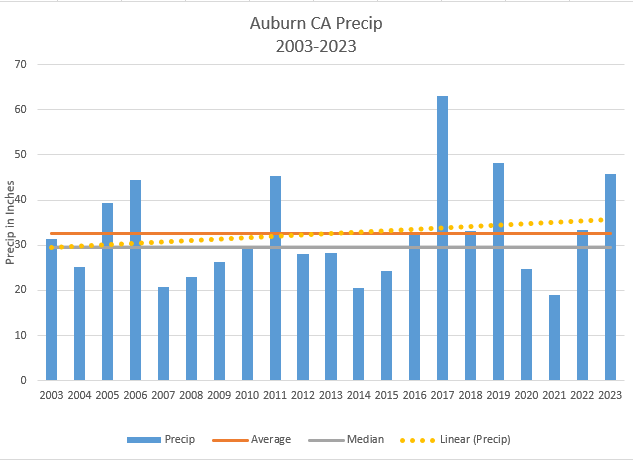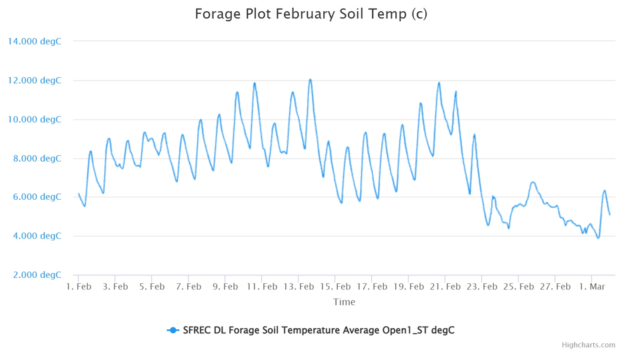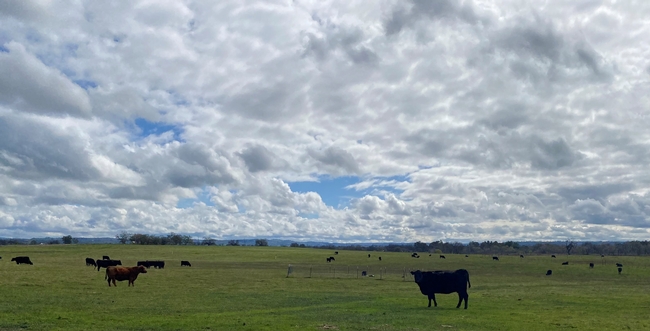Looking back at more than 20 years of precipitation data I've collected since my family moved to Auburn, I can't say that we've ever had an “average” year – that is, we've never had exactly 32.68 inches of rain. Some years, like 2016-17, we measure quite a bit more than average (62.96 inches, to be exact); other years, like 2020-21, we measure less (just 19 inches). Since I started keeping track in 2003, we've had 12 years with less than our average, and 6 years with more than average (the balance – 3 years – have been close to what I would call "normal"). Since 2007, we've experienced several 2-4 year stretches of below average rainfall – including the memorable droughts of 2012-2015 and 2020-2022. Interestingly, though, the trendline on my data suggests that our “average” precipitation has increased slightly since I started keeping track in 2003.
But as anyone who manages livestock on our annual rangelands will tell you, the amount of rainfall we receive is only part of the story when it comes to grass growth – timing and temperature (both soil and air temperature) are key drivers in rangeland forage production. The last two years have provided a stark example!
Think back to mid-March 2022. After an exceptionally wet start to the water year (in October 2021, I measured more than 10 inches of rain), our rangeland forages got off to a great start – they'd germinated in late October and had grown through early December. But in January 2022, the faucet shut off – we received less than 2.5 inches from January 1 through March 31. By some accounts, it was the driest January-March on record. I recall checking soil moisture on the rangelands where our sheep were grazing in mid-March 2022, and finding that we had less than 25% moisture – more like May conditions in the root zone of our rangeland plants.
Despite these dry conditions, however, the UC Sierra Foothill Research and Education Center (SFREC) measured 1,412 pounds of forage per acre on March 1, 2022 (187% of “average” for the date). Rain returned in April 2022, and total forage production at SFREC ended up being 122% of the long term average (just over 3,800 pounds per acre).
In the autumn of 2022, our germinating rain came nearly a month later than the year before – which meant the rangeland forage didn't have much time to grow before the short days and cold temperatures of December forced it into dormancy. A wet and cold December was followed by a wetter (if somewhat warmer) January 2023. While February was slightly drier than “average,” March turned wet and cold again. As of this writing (March 29), we've measured exactly 28 inches of rain at our home place in Auburn since New Year's Day!
Even with all of this moisture, however, forage production at SFREC is lagging significantly behind last year. On March 1, SFREC measured just 619 pounds per acre (less than the long term average for that date of 750 pounds - and less than half of what we had a year ago at this time). As you might expect, soil temperatures followed the cooler air temperatures in late February; cold soils mean little or no forage growth.
Stated another way, we were in a precipitation drought on this date last year – and we had more forage than “average.” This year is shaping up to be one of the wetter years since I've worked in the foothills – and we're short on feed at the moment (a grass drought). With long days and warmer temperatures coming, I suspect the forage will explode in April, but for now, feed conditions in the foothills are tight!
So how do we manage through this kind of uncertainty? As ranchers, how can we set our stocking rates and production calendars given these wide swings in conditions? During our Working Rangelands Wednesdays webinar series last year, Dr. Leslie Roche (our Cooperative Extension Specialist in Rangeland Management) suggested that while the total amount and seasonable distribution of precipitation are the biggest drivers for annual forage production, specific timing is also critical. November and April precipitation are especially important, based on Dr. Roche's analysis. A statewide collaborative effort is ground-truthing remote sensing technology that will hopefully provide real-time forage production data without needing an army of range technicians clipping plots on a weekly basis.
All of this information will help ranchers make decisions about seasonal and annual adjustments to our stocking rates, but good management will always require careful planning and on-the-fly adjustment to the current year's conditions. While While my colleague Grace Woodmansee (Siskiyou County Livestock and Natural Resources Advisor) developed our Drought Decision Support Tool with drought in mind, I'm realizing there's value in putting together a 12-month forage plan regardless of the conditions! There's no such thing as an average year!
